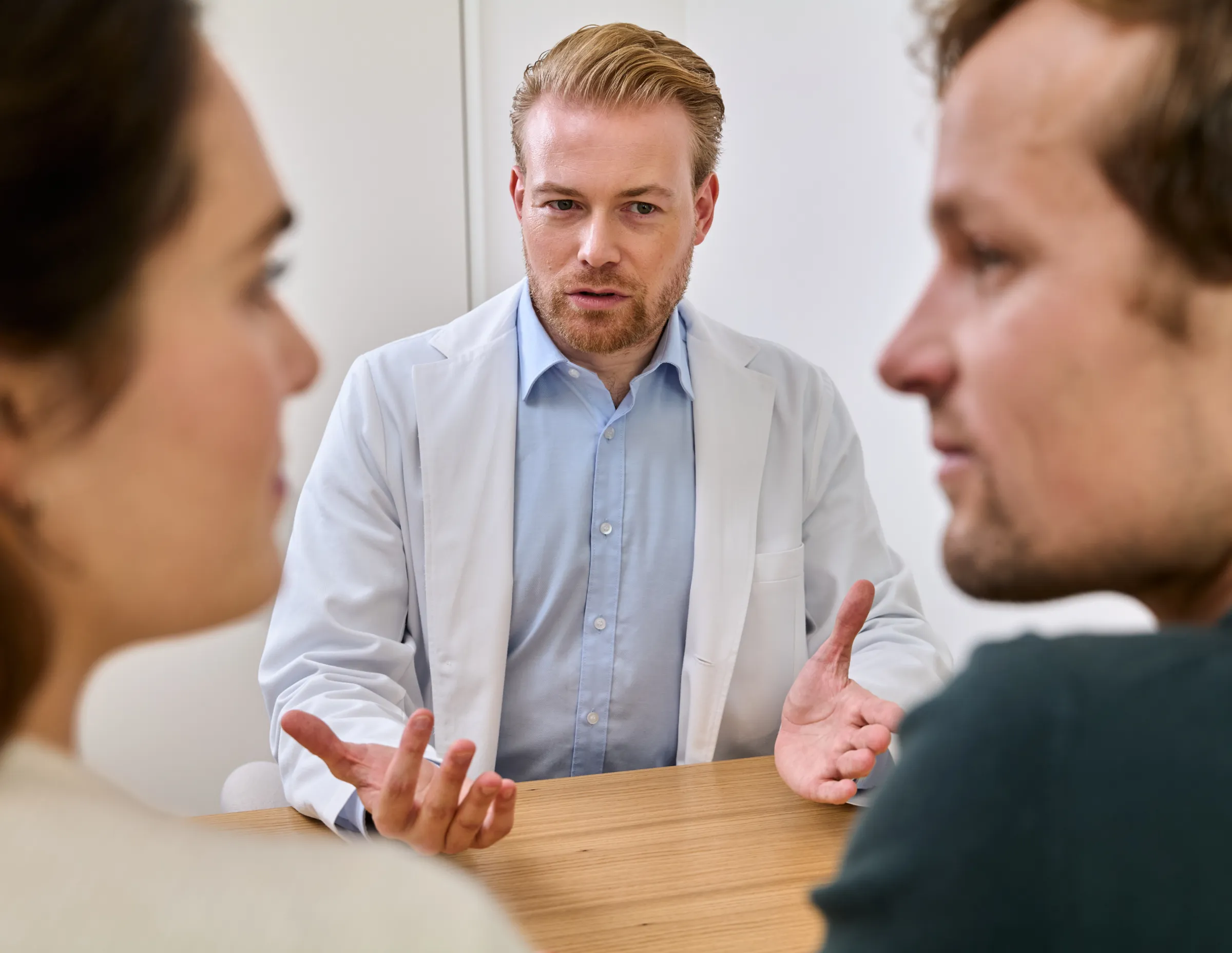What happens when the process of ovulation becomes disrupted? Learn about the symptoms and causes, and how these disorders can be addressed.
Ovulation—the regular release of the egg (oocyte) from the ovary—is one of the most naturally occurring processes in all reproductively mature females. Despite this, many women experience problems with ovulation. This article will give an overview of the problems, causes, and symptoms that arise when ovulation goes wrong.
What is ovulation?
Ovulation is the release of an egg from one of the ovaries during a woman’s menstrual cycle. All stages of the reproductive cycle are essential for getting pregnant naturally, but without ovulation, there is no egg to be fertilised by the sperm and, therefore, no pregnancy.
Ovulation is tightly regulated by endocrine hormones, specifically gonadotropin-releasing hormone (GnRH), follicle-stimulating hormone (FSH), and luteinising hormone (LH) released by the hypothalamus and pituitary gland (regions within the brain) that target the ovary (this process is also known as the hypothalamic-pituitary-ovarian axis). GnRH and FSH trigger the development of a mature egg ready for ovulation, and a surge in LH then allows for the actual ovulation and the release of the egg from the ovary. These hormones, along with the female sex hormones released by the ovaries, such as estrogen and progesterone, work in synergy within a delicate feedback loop in order for the menstrual cycle to function regularly and effectively.
It is not surprising to hear that if there are any problems with the release of these hormones, ovulation may not happen. In fact, according to the World Health Organization (WHO), about 25% of infertility is related to ovulation disorders.
What are the common types of ovulation problems?
Ovulation disorders impact ovulation by causing missing or absent periods or irregular periods. You will likely come across two terms:
- Anovulation – this is the complete absence of ovulation, leading to amenorrhea, or absence of a menstrual period.
- Oligoovulation – this is infrequent or irregular ovulation, often presenting as either long menstrual cycles (more than 35 days) or fewer than 8 cycles per year.
Many factors can trigger anovulation and oligoovulation, such as hormone imbalances, disease, genetics, or lifestyle factors. Your doctor can help you to explore all these factors and determine what might be causing your absent or irregular ovulation.
What are the common types of ovulation disorders?
Ovulation disorders are typically classified into the following three main groups:
- Disorders caused by hypothalamic pituitary failure, characterised by low levels of gonadotropins, including FSH and LH. About 10% of ovulation disorders have this cause. Disorders of this type include:
- Hypothalamic amenorrhea. This is often related to stress, weight loss or excessive exercise. Amenorrhea in this context can be classified as primary (from puberty) or secondary (after puberty, where a woman has previously experienced regular periods). It is caused by a lack of GnRH secretion, which then disrupts the release of FSH and LH, preventing ovulation from occurring.
- Hypogonadotrophic hypogonadism. These are problems (due to genetic or developmental disorders) with the hypothalamus or pituitary gland not producing enough endocrine hormones (GnRH, FSH, or LH) to stimulate the ovaries to ovulate.
2. Dysfunctions with the hypothalamic-pituitary-ovarian axis, which make up about 85% of ovulation disorders. Specific disorders of this type include:
- Polycystic ovarian syndrome (PCOS). This common disorder affecting reproductive-aged women specifically impacts ovulation. It is classified by oligoovulation or amenorrhea, hyperandrogenism, and/or polycystic ovaries seen on ultrasound. Women with obesity also can have increased insulin resistance and worsening of PCOS symptoms.
- Hyperandrogenism is when a woman has high levels of androgen in her body, especially testosterone. High levels keep the follicles in the ovaries immature and prevent development into an egg ready for ovulation. Overweight women, women with PCOS, and women with pituitary gland or adrenal gland issues may experience hyperandrogenism.
- Hyperprolactinemia. Prolactin is a hormone that stimulates milk production in breastfeeding women. When prolactin levels are too high, it can interfere with ovulation. Medications, pituitary tumors, or other underlying medical conditions can also cause this condition.
3. Disorders caused by ovarian failure, responsible for around 5% of ovulation disorders.
- Primary ovarian insufficiency (POI) or premature ovarian failure (POF) is classified as a loss of or irregular periods in women under 40, often related to a low ovarian reserve and a lack of ovulation. It can be caused by autoimmune disorders, chemotherapy, radiation therapy, chromosomal or genetic factors. POI is the preferred term of use.
Other medical conditions can also affect ovarian function. These include:
- Tumors. Both benign and malignant tumors can occur in the ovary, and are mainly solid tissue tumors, while ovarian cysts are fluid-filled and often benign. There are various forms of ovarian tumors depending on the cells where the tumor originates. They can significantly affect ovulation.
- Endometriosis. In this condition, the lining of the uterus (the endometrium) grows outside the uterus and fallopian tubes and causes lesions and adhesions in surrounding regions, such as the ovaries, fallopian tubes, rectum, bladder, and lining of the pelvic cavity (peritoneum). Lesions on the ovaries are known as endometriomas and can prevent ovulation as they can block the ovary and fallopian tube region, or they can embed into the inner tissue of the ovary and prevent normal development of the eggs.
- Thyroid disorders. Both hypothyroidism and hyperthyroidism can interfere with hormonal balance and disrupt the development and release of eggs.
How do you know if you have an ovulation disorder?
The main symptoms of ovulation disorders, as mentioned, are anovulation or oligoovulation. However, various symptoms are reported depending on the cause of anovulation or oligoovulation, and the woman’s health. Often women who experience ovulation issues also have:
- Irregular or absent periods
- Painful periods, pelvic pain or dyspareunia (pain during sex)
- Lack of “egg white” cervical mucus associated with ovulation
- Premenstrual syndrome, such as bloating, mood swings, and breast tenderness
- Excessive hair growth
- Acne
- Infertility
What risk factors are associated with ovulation disorders?
- Age. As women get older, the quality and quantity of eggs declines, making it harder to ovulate and conceive. Eventually, menopause happens, and ovulation will completely stop.
- Stress. Chronic stress may disrupt hormonal balance and affect ovulation.
- Eating disorders. Anorexia and bulimia can cause hormonal imbalances and impact ovulation and the menstrual cycle.
- Weight. Overweight or obese women are at increased risk of having ovulation disorders, such as PCOS, mainly due to the effect of excess body fat on hormonal balance.
- Previous surgery. Surgery such as the removal of one or both fallopian tubes (Salpingectomy), surgical removal of fibroids from the uterus (myomectomy), or laparoscopy could cause damage to the ovary and increase the risk of dysregulated ovulation.
- Sexual history. Sexually transmitted infections, such as chlamydia, can cause damage to ovaries or fallopian tubes, or lead to pelvic inflammatory disorders, which can affect regular ovulation. Testing for infections and treating them as soon as possible is important to avoid long-term damage.
- Alcohol and smoking. Both can disrupt the hormonal balances in the body, interfering with the menstrual cycle and potentially ovulation. Women with reproductive issues are strongly recommended to abstain from alcohol and smoking.
How do doctors regulate ovulation?
Treatment may be minimal and require only a slight adjustment in your hormonal or lifestyle choices to rectify issues with ovulation, or you may require more medicated or surgical approaches to help regulate your menstrual cycle and fertility issues. Here are a few methods that you may come across:
Lifestyle interventions that focus on normalizing body weight (aim for BMI >19) and promoting moderate exercise (as excessive exercise can be detrimental) and healthy lifestyle choices (including healthy eating and avoiding smoking and excessive alcohol intake).
Metformin is an approved oral anti-diabetic drug that helps improve insulin sensitivity and control high blood glucose levels. It helps to induce weight loss in overweight people, therefore, it may be given to women who are obese and experiencing irregular periods. Metformin should be used in combination with lifestyle interventions, such as healthy eating and exercise, and has been used in combination with fertility drugs to help improve insulin levels and infertility, especially in the context of PCOS.
Clomiphene citrate is an ovulation induction therapy. It can be taken early in the menstrual cycle (1–5 days), and the dose can be increased if no ovulation is seen after several cycles of use. If you try several rounds of clomiphene citrate and still no ovulation occurs, you may be described as ‘clomiphene resistant’ and the doctor may try a different approach.
Letrozole is another ovulation induction therapy used to stimulate ovulation, belonging to the aromatase inhibitor drug family. It acts to decrease estrogen levels, which can help stimulate FSH and LH and induce ovulation. It is taken as an oral tablet for several days at the beginning of the menstrual cycle.
Pulsatile GnRH can induce ovulation and consequently increase pregnancy and birth rates. It mimics the natural pulse of GnRH from the hypothalamus, which in turn stimulates the pituitary gland to release FSH and LH to induce ovulation. It is delivered using a small pump-like device to deliver the pulses at specific times, and is usually started on the first day of the menstrual cycle.
Laparoscopy is usually used to investigate a cause of infertility, such as endometriosis, adhesions, or tubal abnormalities, but it can also be used to administer treatment. Laparoscopy diathermy involves delivering electrical currents to the ovary to encourage ovulation. In this procedure, there is a small risk of damaging the ovary or surrounding tissue, and the procedure is done under general anaesthesia.
Assisted reproductive technology (ART), such as in vitro fertilization (IVF) or intrauterine insemination (IUI) are options for women experiencing an irregular menstrual cycle and infertility. Many of the techniques aim to induce ovulation and could result in ovarian hyperstimulation syndrome (especially in PCOS) and multiple pregnancies, which can be high-risk. Your fertility expert will take you through the options of ART once they have thoroughly investigated your condition and health status.
We spoke to an IVF director, Anate Aelion, and asked what the best treatment was for women with ovulation problems, and this is her advice:
The best course of treatment depends on the etiology of an ovulation. If the etiology is polycystic ovarian syndrome, for example, one of the most common ones, then letrozole is the drug of choice. If a woman is not ovulating due to a hypothalamic disorder— i.e., their brain is not making the hormones needed to tell the ovary to grow an egg, the treatment is most likely injectable gonadotropins.
How do doctors check if I’m ovulating?
Tests are available to help pinpoint the causes of ovulatory problems; these can measure hormone levels, detect changes in cervical mucus, and look at follicular growth and ovulation. Doctors might suggest using some of the following as part of a thorough investigation:
Period tracking. Tracking your periods can help inform your doctor of how many periods you are having, and how regular they are. It’s good practice to note all symptoms during your menstrual cycle, however minor, in case they are related to an underlying condition.
Basal temperature tracking. Women have a slight increase in their basal body temperature during ovulation. Tracking your daily temperature upon waking could help identify when you are ovulating.
Blood tests. Commonly, a doctor will request a blood test, maybe at a specific time of your menstrual cycle, to determine levels of anti-Müllerian hormone (AMH), FSH and LH.
Transvaginal ultrasound. A vaginal ultrasound can allow the doctor to visualize the uterus, cervix and ovaries, and helps identify cysts, fibroids, or other apparent abnormalities. An ultrasound can be used to look at follicular growth and ovulation, but it is usually used with other tests for ovulation.
How do I get a test to check my ovulation status?
Ideally, you should be having a regular gynecological control, in which your doctor will do a pelvic examination, pap test, and smear test to assess your uterus, cervix and ovaries.
If you are experiencing unexpected irregular or missed periods, make an appointment to discuss this with your gynecologist.
If you are trying to conceive and have been having unprotected sex at the time of your predicted ovulation but have not conceived within 6–12 months, then make an appointment with a fertility specialist; they can start a fertility workup to examine if there are any underlying issues with you or your partner.
Takeaway
Various forms of ovulation disorders can be caused by hypothalamic or pituitary failure, dysfunctions within the hypothalamic-pituitary-ovarian axis, or ovarian failure. Identifying why you may be experiencing problems with your ovulation is key to maintaining a healthy menstrual cycle. If you recognize changes in your menstrual cycle or are having difficulties getting pregnant, speak with your doctor to determine why this may be happening. There are various treatment options, from lifestyle to medicated and assisted reproductive therapies, but your doctor can offer you the best advice and guidance.
Would you like to discuss any of the issues mentioned in this article? At Cada, our dedicated team can work with you and your partner in getting to the bottom of your ovulation issues and help you on your fertility journey. Reserve your spot for a personalised consultation today.







